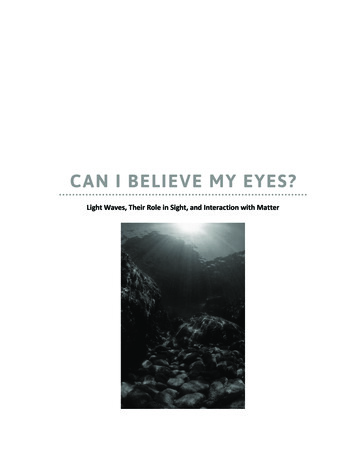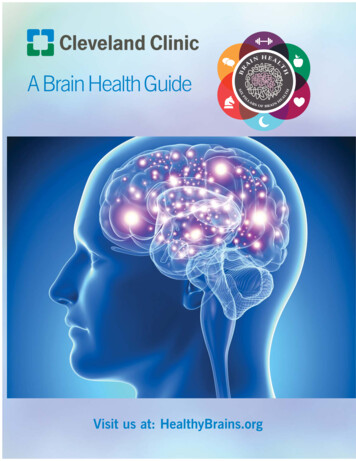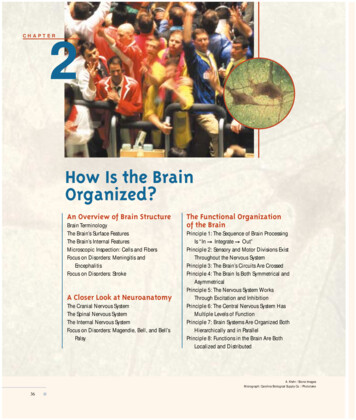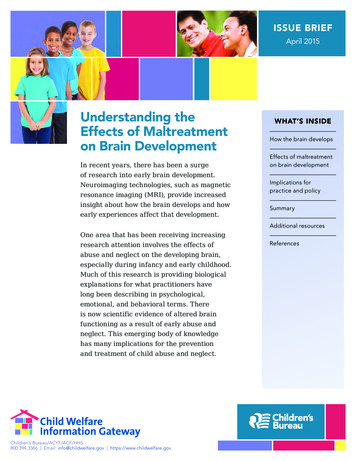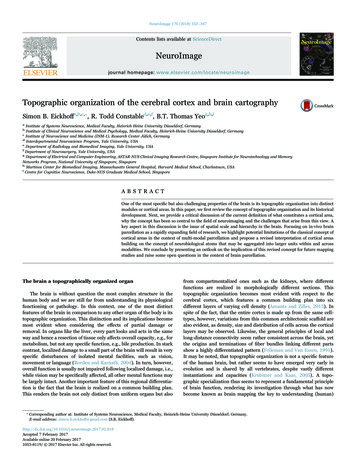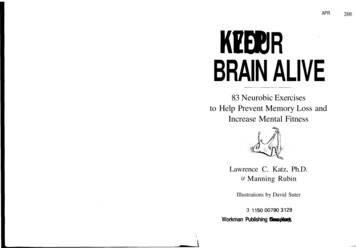
Transcription
APRKEEPYOURBRAIN ALIVE83 Neurobic Exercisesto Help Prevent Memory Loss andIncrease Mental FitnessLawrence C. Katz, Ph.D.& Manning RubinIllustrations by David Suter3 1150007903129Workman Publishing Company, New York2000
ACKNOWLEDGMENTSCopyright 1999 by Lawrence C. Katz and Manning RubinIllustrations copyright David SuterCover and book design: Elaine TomAll rights reserved. No portion of this book may be reproduced—mechanically,electronically, or by any other means, including photocopying—withoutwritten permission of the publisher. Published simultaneously inCanada by Thomas Alien 8c Son Limited.Library of Congress Cataloging-in-Publication DataKatz, Lawrence, 1956Keep your brain alive: the neurobic exercise program/by Lawrence C. Katzand Manning Rubin.p. cm.ISBN 0-7611-1052-61. Cognition—Age factors. 2. Cognition—Problems, exercises, etc. 3. Memory—Agefactors. 4. Cognition—Problems, exercises, etc. 5. Aging—Psychological aspects.I. Rubin, Manning. II. Tide.BF724.55.C63K38 1998153—dc2198-18888CIPWorkman books are available at special discounts when purchased in bulkfor premiums and sales promotions as well as for fund-raising or educational use.Special editions or book excerpts can also be created to specification.For details, contact the Special Sales Director at the address below.Workman Publishing Company, Inc.708 BroadwayNew York, NY 10003-9555Printed in the United States of AmericaFirst printing May 199910 9 8 7 6We both thank Peter Workman for being our matchmaker, and our editor, Ruth Sullivan, for her steadfastfaith in the project and her relentless pursuit of clarity andsimplicity in the writing and organization of the material.Larry Katz wishes to thank Doris larovici, his spouse, forher critical insights, advice, and editorial assistance, and BonnieKissell, for unflagging administrative support of this project.Manning Rubin thanks Jane Rubin, for bearing the bruntof his burying himself in the research, writing, and rewritinghe has been obsessed with for two years, and for her levelheaded observations that helped the book. And he thanksLarry for the voluminous work he has produced in keepingthis book alive.
CONTENTSPreface . . . . . . . . . . . . . . . . . . . . . . . . . . . . . . . . . . . . . . . . .ixC H A P T E RINeurobics: The New Science of Brain Exercise . . . . . . . . . . 1C H A P T E RIIHow the Brain Works . . . . . . . . . . . . . . . . . . . . . . . . . . . .9C H A P T E RIIIHow Neurobics W o r k s . . . . . . . . . . . . . . . . . . . . . . . . . . . . 3 1C H A P T E RIVStarting and Ending the Day . . . . . . . . . . . . . . . . . . . . . . .41C H A P T E RVCommuting . . . . . . . . . . . . . . . . . . . . . . . . . . . . . . . . . . . .53CHAPTERVIAt Work . . . . . . . . . . . . . . . . . . . . . . . . . . . . . . . . . . . . . 7 - 7C H A P T E RVIIAt the M a r k e t . . . . . . . . . . . . . . . . . . . . . . . . . . . . . . . . .87CHAPTERVIIIAt Mealtimes . . . . . . . . . . . . . . . . . . . . . . . . . . . . . . . . . . .99C H A P T E RIXAt Leisure . . . . . . . . . . . . . . . . . . . . . . . . . . . . . . . . . . .117
PREFACEAs the population of over 76 million Baby Boomers approaches middle age and beyond, the issue of preservingmental powers throughout greatly increased life spans hasreached an almost fever pitch. There is a growing interestin—and optimism about—preserving and enhancing thebrain's capabilities into senior years. With the help of powerful new tools of molecular biology and brain imaging, neuroscientists around the world have literally been looking intothe mind as it thinks. Almost daily, they are discovering thatmany of the negative myths about the aging brain are, indeed, only myths: "Older and wiser" is not just a hopefulcliche but can be the reality. In much the same way that youcan maintain your physical well-being, you can take charge ofyour mental health and fitness.Although new and therefore not yet proved by a largebody of tests, Neurobics is based on solid scientific ground; itis an exciting synthesis of substantial findings about the brainthat provides a concrete strategy for keeping the brain fit andflexible as you grow older.
KEEPYOURB R A I NALIVEFrom Theory to PracticeJane reached into her pocketbook and fished inside for thekeys to her apartment. Usually they were in the outside flap pocket but not today. "Did I forget them?!No. .here they are." She felt their shapes to figureout which one would open the top lock. It took hertwo tries until she heard the welcome click of thelock opening. Inside the door she reached tothe left for the light switch. but whybother? Her husband would do thatlater. Touching the wall lightly with herfingertips, she moved to the closet on the right,found it, and hung up her coat. She turned slowly and visualizedin her mind the location of the table holding her telephone and answering machine. Carefully she headed in that direction, guidedby the feel of the leather armchair and the scent of a vase of birthday roses, anxious to avoid the sharp edge of the coffee table andhoping to have some messages from her family waiting.The table. The answering machine. She reached out andbrushed her fingers across what she believed to be the play button."What if I push the delete button?" she thought, and again checkedto make sure she was right. Yesterday it was so easy. She could havePREFACEdone all this simply by looking around. Today was different. Shecould see nothing.But Jane had not suddenly gone blind. At age 50, she wasintroducing a lifestyle strategy called Neurobics into her dailyactivities. Based on recent discoveries in brain science, Neurobics is a new form of brain exercise designed to help keepthe brain agile and healthy. By breaking her usual homecoming routine, Jane had placed her brains attentional circuits inhigh gear. With her eyes closed, she had to rely on her sensesof touch, smell, hearing, and spatial memory to do somethingthey rarely did—navigate through her apartment. And shewas involving her emotional sense by feeling the stresses ofnot being able to see. All these actions created new and different patterns of neuron activity in her brain—which is howNeurobics works.This book will explain the principles behind Neurobicsand how the exercises enhance the overall health of yourbrain as you grow older.
NEUROBICS:The New Science ofBrain Exercise( \ Tf "That was the name of that actor who was in all the earlyV V Woody Alien films? You know. curly brown hair. ?"The first time you forget the name of a person you shouldknow, a movie title, or an important meeting, you're likely toexclaim—only half-jokingly—"I'm losing it! My brain isturning to Jell-O." Reinforced by messages and images in themass media, you equate mild forgetfulness with the firststages of accelerating mental decline.". .He was just in a Broadway show with, um, what's-her-name.Oh, God, you know who I mean."And maybe they do remember it's Tony Roberts. But if theydon't, you become frustrated and preoccupied trying to recallthis buried name. Usually beginning in your forties or fifties—sometimes even in your thirties—you start to notice thesesmall lapses: not remembering where you put the car keys or
KEEPYOURB R A I NA L I V Ewhat was on the grocery list you left at home. .or being unableto understand the instructions for a new VCR or computer. . .or forgetting where the car is parked because you leftthe mall through a different door.Even though these small lapses don't actually interferemuch with daily life, the anxiety they provoke can. You worrythat you'll become just like your Aunt Harriet, who can remember details of events from the Depression but not what shedid yesterday. Firsthand experiences with people who have difficulty with perception and memory as they age can make youanxious when you suddenly forget something ordinary. Nowonder you jump to the conclusion that aging is an inevitableslide into forgetfulness, confusion, or even the first stages ofAlzheimer's disease.The good news, however, is that mild forgetfulness is nota disease like Alzheimer's and action can be taken to combatit. Recent brain research points to new approaches that canbe incorporated into everyday activities to develop and maintain brain connections. By adopting these strategies, you mayactually enhance your brain's ability to deal with declines inmental agility.There are numerous myths about the aging brain thatneuroscientists are disproving daily. With the help of excitingN E U R O B I C Snew technologies, the traditional view of the way the brainages is being rapidly revised. Evidence clearly shows that thebrain doesn't have to go into a steep decline as we get older.In fact, in 1998, a team of American and Swedish scientistsdemonstrated for the first time that new brain cells are generated in adult humans.1Also contrary to popular belief, the mental decline mostpeople experience is not due to the steady death of nerve cells.2Instead, it usually results from the thinning out of the numberand complexity of dendrites, the branches on nerve cells that directly receive and process information from othernerve cells that forms the basis of memory. Dendrites receive information across connections calledsynapses. If connections aren't regularlyswitched on, the dendrites can atro- phy. This reduces the brains ability i L J 'F need * I** r ry' ' I communicatto put new information into memory .' ;/ \y - to «»-„as well as to retrieve old information. \ healthy.Growing dendrites was long thought to be possible onlyin the brains of children. But more recent work has shownthat old neurons can grow dendrites to compensate for losses?Other experiments show that neural circuits in adultbrains have the capacity to undergo dramatic changes—an
K E E PY O U RR A I NA L I V EN E U R O B I C Sability scientists thought was lost after childhood. The agingbrain, however, continues to have a remarkable ability to grow,adapt, and change patterns of connections."Discoveries like these are the basis of a new theory ofbrain exercise. Just as cross training helps you maintain overall physical fitness, Neurobics can help you take charge ofyour overall mental fitness.Neurobics aims to help you maintain a continuing level ofmental fitness, strength, and flexibility as you age.The exercise program calls for presenting the brain withnonroutine or unexpected experiences using various combinations of your physical senses—vision, smell, touch, taste, andhearing—as well as your emotional "sense." It stimulates patterns of neural activity that create more connections betweendifferent brain areas and causes nerve cells to produce naturalbrain nutrients, called neurotrophins, that can dramatically increase the size and complexity of nerve cell dendrites.5 Neurotrophins also make surrounding cells stronger and moreresistant to the effects of aging.Neurobics is very different from other types of brain exercise, which usually involve logic puzzles, memory exercises,and solitary practice sessions that resemble tests. Instead,Neurobic exercises use the five senses in novel ways to enhance the brain's natural drive to form associations betweendifferent types of information. Associations (putting a nametogether with a face, or a smell with a food, for example) arethe building blocks of memory and the basis of how we learn.Deliberately creating new associative patterns is a central partof the Neurobic program.Putting together the neuroscience findings (pages 6-7)with what scientists already know about our senses led directly to our concept of using the associative power of the fivesenses to harness the brain's ability to create its own naturalnutrients. In short, with Neurobics you can grow your ownbrain food—without drugs or diet.The word Neurobics is a deliberate allusion to physical exercise. Just as the ideal forms of physical exercise emphasize usingmany different muscle groups to enhance coordination and flexibility, the ideal brain exercises involveactivating many different brain areasin novel ways to increase the rangeof mental motion. For example, anexercise like swimming makes thebody more fit overall and capableof taking on any exercise. Similarly,
KEEPYOURR A I NA L I V EN E U R O B I C STHE SCIENTIFIC BASISFOR NEUROBICSNeurobics rests on much more than a single breakthroughfinding. It is a synthesis of important new informationabout the organization of the brain, how it acquires andmaintains memories, and how certain brain activities produce natural brain nutrients. These findings include:3. The brain is richly endowed with specific molecules--liheneurotrophins—which are produced and secreted bynerve cells to act as a kind of brain nutrient that actuallypromotes the health of these nerve cells as well as thehealth of their neighbors and the synapses tjetweea .tib«opu*.1. The cerebral cortex, the seat of higher learning in thebrain, consists of an unexpectedly large number of different areas, each specialized to receive, interpret, andstore information from the senses. What you experiencethrough the senses doesn't all end up in one place in thebrain.4. The amount of neurotrophins produced by neiw c Hs- and how well nerve cells respond to nmade by other nerve cells—is regulated by howrthose nerve cells are. In other words, thebrain cells are, the. more growtii-sisteBuJating 'i i i they produce and die better they .respond/-2. Connecting the areas of the cerebral cortex are hundredsof different neural pathways, which can store memoriesin almost limitless combinations. Because the system isso complex and the number of possible combinations ofbrairt pathways so vast, we employ only a small fractionof the possible combinations.5. Specific kinds of sensory stimulation, especially lumwo"*tine experiences that produce novel activity pattsfn innerve cell circuits, can produce greater quantities' *these growth-stimulating molecules.8
K E E PY O U RB R A I NA L I V ENeurobics makes the brain more agile and flexible overall so itcan take on any mental challenge, whether it be memory, taskperformance, or creativity. That's because Neurobics uses anapproach based on how the brain works, not simply on how toHOW THEBRAIN WORKSwork the brain.The brain receives, organizes, and distributes information toguide our actions and also stores important informationfor future use. The problems we associate with getting older—forgetfulness, not feeling "sharp," or having difficulty learningnew things—involve the cerebral cortex and the hippocampus.Motor Cortex muscle control and coordinationSomatosensory CortextouchPremotor Cortexmuscle coordinationVisualAssociationAreasPrefrontal CortexVisual Cortexvisionsocial behavior,abstract reasoning,higher cognitivefunctionsAuditory CortexhearingTHE CORTEXthe seat of higher brain function
KEEPYOURB R A I NHOWA L I V ETHEB R A I NWORKSTHE CEREBRAL CORTEX AND HIPPOCAMPUSTHE LIMBIC SYSTEMCorpus Callosumbrain areas involved in processing emotionsbridge of nerve tissueconnecting the left andright hemispheresCerebral Cortexinvolved in sensoryprocessing, abstractreasoning, andstoring andretrieving memoriesThalamussensory messages tothe brain are sortedin the thalmus androuted to the properreceiving centers inthe cortexHippocampuscritical in forming andretrieving memory andin creating mental mapsOlfactory Bulbsinformation from the olfactorybulbs connects directly to thecortex, the amygdala(emotional center), and thehippocampus (memory). Thismay account for the strongmemories and emotions thatcan be evoked by smellsCerebellumhandles physicalcoordinationThe cortex is the part of the brain that is responsible for ourunique human abilities of memory, language, and abstractthought. The hippocampus coordinates incoming sensory information from the cortex and organizes it into memories. Thewiring of the cortex and hippocampus is designed to form links(or associations) between different sensory representations ofthe same object, event, or behavior.10Most pictures of the brain usually show the deeply groovedand folded cerebral cortex: a thin sheet of cells (no thickerthan twenty pages of this book) wrapped around the other"core" parts of the brain like a rind on a grapefruit. Althoughthin, the cortex is very large (spread out it would cover thefront page of a newspaper) and contains an astounding number of nerve cells—about one hundred million in every squareinch. And while the cortex may look like a uniform sheet, itactually consists of dozens, perhaps hundreds, of smaller, specialized regions (some as small as a fingernail, others as largeas a credit card). Each of the senses has its own dedicatedportions of cortical real estate—for example, there are at leastthirty specialized areas just for vision.Processing information as it comes in from the senses involves a network of many smaller regions. In addition, other regions of the cortex specialize in integrating information fromtwo or more different senses (so, for example, when you hear asound you know where to look).These hundreds of regions are linked together by thebrains equivalent of wires: thin threads called axons (each onlyone hundredth the thickness of a human hair) that extend11
HOWK E E PY O U RB R A I \There are 30 specialized areas inthe visual cortexalone; each arealinks up (communicates) with itsneighbors (shownhere in simplifiedform). A realisticdiagram wouldshow over 200linkages.from nerve cells andconduct electrical impulses from one part ofthe brain to another.Every cortical regionsends and receives millions of impulses viathese axons to and fromdozens of other corticalregions. The brain contains literally hundredsof miles of such wires.Thus, the cortex resembles an intricate web,T H EB R A I NVISUAL AREAS OF THE CORTEXwith each region linked directly or indirectlyto many other regions. Some of these connections are betweenareas that process similar information, such as the thirty involving vision, while other connections are between dissimilarareas, such as touch and smell. The network of pathways between cortical regions that do many different things is whatallows the cortex to be so adept at forming associations.Like the cortex, the hippocampus plays an important rolein forming associations. The senses continually flood the brainwith information, some of it vital but much of it unimportant.You don't need to remember the face of everyone you pass onthe street, but you do want to recognize someone you just metat your boss's party! To prevent the information overload thatwould accompany having to remember too much, the hippocampus sifts through the barrage of incoming informationfrom the cortex and picks out what to store or discard. In otherwords, the hippocampus acts like a central clearinghouse, deciding what will be placed into long-term memory, and then,when called upon, retrieving it. The hippocampus's decision tostore a memory is believed to hinge on two factors: whetherthe information has emotional significance, or whether it relates to something we already know.The hippocampus is also vital for making mental maps,allowing us to remember things like where our car is parkedor how to get from home to work. Animals in which the hippocampus has been removed cannot learn or remembersimple mazes.Most problems that cause mental deficiencies involve thecerebral cortex or the hippocampus. So keeping mentally fit really means exercising these parts of our brain so they functionat their best. And what they do best is to form associations between different kinds of information they receive.1312W O R K SA L I V E
KEEPYOURB R A I NALIVEASSOCIATIONS: How WE LEARNAssociations are representations of events, people, and placesthat form when the brain decides to link different kinds of information, especially if the link is likely to be useful in the future. The raw material for associations originates primarilyfrom the five senses but also can be emotional or social cues.The brain takes several different things into account in deciding whether to forge these mental connections. For example, ifsomething provides inputs to two or more senses close together in time, like the sight, smell, and taste of a cheeseburger, the brain will almost automatically link the sensations.In essence, this is our basic learning process.The classic example of associative linking, often taught inintroductory psychology courses, is Dr. Ivan Pavlov's experiments with dogs. Dogs normally salivate at the sight of food.Every day when Pavlov fed the dogs, he rang a bell. After afew days, just ringing a bell made the dogs salivate, even if nofood was presented.These dogs made an association—a connection withintheir brains—that a certain sensory stimulus (the bell) meantfood. Consequently, the sound of the bell alone made thebrain instruct the salivary glands to get ready for food. Hu-14HOWTHEB R A I NW O R K Smans and animals can form similar links between almost anykind of sensory inputs.Obviously, humans are capable of much more sophisticatedand abstract learning that isn't as closely tied to external stimuli(like bells) or external rewards (like food). Take learning a language, for example. An infant learns language by associating aparticular set of sounds with a certain behavior, person, or object. (An explicit reward may or may not be present.)Once such associations are formed, they reside in thebrain as a long-term memory, which can be accessed just byexperiencing the original stimulus. It's rather astoundingwhen you think about it: A certain kind of sensory experiencecan permanently change the wiring in part of your brain!Most of what we learn and remember relies on the abilityof the brain to form and retrieve associations in much thesame way as Pavlov's dogs learned that a bell meant food. Forexample, you pick up a rose, and its smell activates the olfactory(smelling) parts of the cortex, its image activates the visualareas, and the soft petals or sharp thorns activate the feelingsections. All these different sensations cause nerve cells invery different areas of the cortex to be activated at the sametime in a particular pattern, strengthening some of the linkages between these areas.15
K E E PY O U RR A I NA L I V EOnce that happens, anything that activates just part of thenetwork will activate all the areas of the brain that have representations of rose events. Someone hands you a rose, and as youhold it, you may remember your first wedding anniversarywhen you received a dozen roses, which reminds you of yourfirst apartment in that awful building with the broken elevator.Or the smell of roses reminds you of Aunt Harriet's rose gardenin late summer where you had picnics with your cousin Arniewho is now living in California and whom you keep meaning tocall—all sorts of memories result from a single stimulus.K you just see a rose, you activate only a small number of neuralpathways (bold arrows, left segment) within the visual cortex.But if you smell, touch, and see a rose, a much larger number of direct and indirectpathways between the olfactory, visual, and tactile areas are activated (above, rightsegment). These associative linkages between senses help in memory recall.16HOWTHER A I NW O R K SMEMORYExisting programs for brain exercise have ignored this powerful associative route to forming and retrieving memories.Neurobics seeks to access it by providing the cortex with theraw material that will create new and potent associations.Because each memory is represented in many different cortical areas, the stronger and richer the network of associationsor representations you have built into your brain, the more yourbrain is protected from the loss of any one representation.1Take the common problem of remembering names.When you meet a new person, your brain links a name to afew sensory inputs, such as his appearance (visual). When thebrain is younger, these few associations are strong enough sothat the next time you see this person, you recall his name.But the more you age, the more people you've met, leavingfewer unique visual characteristics available to represent eachnew person, so the associative links between visual characteristics and names are more tenuous. Now, imagine closingyour eyes in the course of meeting someone. Sensory inputs,other than vision, become much more important as the basisfor forming associations necessary for recalling a name: thefeel of his hand, his smell, the quality of his voice.17
K E E PYOURB R A I NOrdinary First MeetingA L I V ENeurobic First MeetingiName Recall: If you use only sight when you meet someone, you're less likely to remember his name. If, on the other hand, you use all your senses, you'll have many more assoclations-'thinnlng hair, middle-aged, glasses, hand feels like a damp, limp rag,clothes smell like a smokehouse, voice sounds like a bullfrog"-to recall his name.You have now tagged someone's name with not just one ortwo associations, but at least four. If access to one associativepathway is partly blocked ("Gosh, he looks familiar"), you cantap into associations based on other senses and do an end runaround the obstruction. Adopting the strategies of formingmultisensory associations when the brain is still at or near itspeak performance—in the forties and fifties—builds a bulwarkagainst some of the inevitable loss of processing power later inlife. If your network of associations is very large, it's like having a very tightly woven net, and the loss of a few threads isn'tgoing to let much fall through.18HOWTHEB R A I NW O R K SThese multisensory representations for tasks like remembering names were always available to you, but early on, yourbrain established an effective routine for meeting people thatrelied primarily on visual cues. An important part of the Neurobic strategy is to help you "see" in other ways—to use othersenses to increase the number and range of associations youmake. The larger your "safety net," the better your chances ofsolving a problem or meeting a challenge because you simplyhave more pathways available to reach a conclusion.More often than not, adults don't exploit the brain's rich potential for multisensory associations. Think of a baby encountering a rattle. She'll look at it closely, pick it up, and run herfingers around it, shake it, listen to whether it makes a sound,and then most likely stick it in her mouth to taste and feel itwith her tongue and lips. The child's rapidly growing brain usesall of her senses to develop the network of associations that willbecome her memory of a rattle.Now think of yourself finding a rattle on the floor.Most likely, you'll just look at it and instantly catalog it:"It's a rattle." The point is that a child is constantly tappinginto the brain's ability to strengthen and increase connectionsbetween its many regions—for smelling, touching, hearing,tasting, and seeing—to produce an ever-growing tapestry19
KEEPYOURB R A I NA L I V EHOWTHER A I NW O R K SYou may be reading this and thinking, "I lead a fairly activelife and my brain seems pretty stimulated. Sure, I have myroutines, but it's not like I don't see new movies, listen to newsongs on the radio, watch TV, or meet new people."The truth, however, is that most of us go through our adultlives engaged in a series of remarkably fixed routines. Thinkabout your average week. .or day-to-day life. Really, how dif-ferent are your commutes, your breakfasts, lunches, and dinners, week in and week out? And what about things like shopping and laundry? It's startling to realize just how predictableand free from surprises our everyday lives really are and, as aconsequence, how little we tap into our brain's ability to makenew associations.Now, routines are not necessarily bad. People created routines because until recent times, the world was unpredictable,and finding food and shelter was filled with risk anddanger. Once reliable sources of food, water, and shelter werediscovered, it made sense to continue in the same patternsthat allowed them to be obtained with a minimum of risk.Discovering and practicing successful routines in anunpredictable world ensured survival.But in our late-twentieth-century, middle-class Americanlives, such unpredictability is largely gone. Food is readilyavailable at the local supermarket; water flows from the tap;weather-resistant, heated and cooled houses shrug off the climate. Modern medicines ward off most common diseases.We even count on the fact that our favorite TV shows aireach week at the same time.2What consequences does this predictability have on thebrain? Because routine behaviors are almost subconscious,2021of associations.and neural activity.Adults miss out on this multisensory experience of new associationsand sensory involvement because wetend to rely heavily on only one or twosenses. As we grow older, we find thatlife is easier and less stressful whenit's predictable. So we tend to avoidSimultaneous sensorynew experiences and develop routinesinput creates a neuralaround what we already know and feel"safety net" that trapsinformation for futurecomfortable with. By doing this, wereduce opportunities for making new access.associations to a level that is less than ideal for brain fitness.ROUTINES CAN BE BRAIN-DEADENING
K E E PY O U RR A I NA L I V Ethey are carried out using a minimum of brain energy—andprovide little brain exercise. The power of the cortex to formnew associations is vastly underutilized.If you drive or walk to work via the same route every day,you use the same brain pathways. The neural links betweenbrain areas required to perform that trip become strong. Butother links to areas that were initially activated when theroute was novel—such as a new smell, sight, or sound whenyou rounded a certain corner—get weaker as the trip becomes routine. So you become very efficient at getting frompoint A to point B, but at a cost to the brain. You lose out onopportunities for novelty
senses to harness the brain's ability to create its own natural nutrients. In short, with Neurobics you can grow your own brain food—without drugs or diet. The word Neurobics is a deliberate allusion to physical exer-cise. Just as the ideal forms of physical exercise emphasize using many different muscle groups to enhance coordination and flexi-File Size: 2MB




